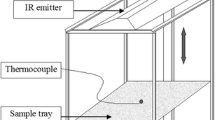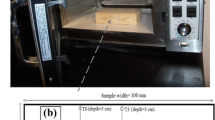Abstract
Microwave heating was recently approved by the FAO as a significantly effective phytosanitary treatment for wood packaging material. According to ISPM 15 (FAO 2009), the target organisms are eradicated if a temperature higher than 60 °C is maintained for 60 s across the entire profile of the board (i.e. 60 °C/60 s). A study using pallet boards was carried out in order to set up a treatment program that would meet ISPM 15 requirements in terms of wood temperature and insect mortality. A 4 m-long industrial tunnel oven (maximum power of 28.8 kW) was used to carry out the experiments. Temperature was measured by means of a VarioCAM® infrared camera. The most relevant results found were: (i) achieving a mean temperature of 63.2 °C (Populus sp.) or 64.8 °C (Pinus sylvestris L.) on the upper surface of 22 mm-thick boards enabled compliance with FAO requirements (i.e. 60 °C/60 s), whatever the moisture content, basic density and initial temperature of the wood (provided the latter exceeded 0 °C); (ii) larvae >150 mg represented the most microwave-resistant life stage of Hylotrupes bajulus L.; (iii) the mortality rate of the larvae was influenced by the moisture content of the boards. Using the Gompertz model, the upper surface temperature was estimated that would be needed to achieve a 99.99683 % mortality rate (the Probit 9 mortality level of efficacy) for the most microwave-resistant life stage of H. bajulus. This temperature was estimated to be 46.8 and 57 °C for wood with >50 and <25 % moisture content, respectively.







Similar content being viewed by others
References
Andreuccetti D, Bini M, Ignesti A, Gambetta A, Olmi R (1994) Microwave Destruction of Woodworms. J Microw Power Electromagn Energy 29(3):153–160
Anglade P, Cangardel H, Fleurat-Lessard F (1979) Applications of high-frequency electromagnetic waves and microwaves to kill insects in stored product. In: Paper presented at the Proc. 14ème Symp. Int. Appl. Energétiques Micro-ondes (IMPI), Monaco, Jun 1979, pp 67–69. (in French)
Antti AL (1993) Microwave drying of hardwood: potentials for Moisture flux. Licentiate Thesis, Luleå University of Technology
Antti AL, Perré P (1999) A microwave applicator for on line wood drying : temperature and moisture distribution in wood. Wood Sci Technol 33:123–138
Bisceglia B, Leo RD, Diaferia N (2009) MW Pallets Disinfestations. Journal of microwave power & electromagnetic energy online. http://jmpee.org/JMPEE_PDFs/Issue-43(4)/JMPEE-841-Bisceglia.pdf. Accessed Dec 13, 2012
CEN (2008) CEN/TS 839 - Wood preservatives. In: Determination of the protective effectiveness against wood destroying basidiomycetes. Application by surface treatment. vol CEN/TS 839. European Committee for Standardization, European Committee for Standardization, Brussels, Belgium
Chanrion P, Level O (1999) Wooden palettes and boxes- Characteristics – production – reconditioning – recycling. (in French) 2nd edn. CTBA, Paris, France, p 171
Crocker RL, Morgan DL, Longnecker MT (1987) Effects of microwave treatment of live oak acorns on germination and on Curculio sp. (Coleoptera: Curculionidae) larvae. J Econ Entomol 80:916–920
Davison AC, Hinkley DV (1997) Bootstrap Methods and Their Applications. Cambridge University Press, Cambridge, p 583
Denlinger DL, Yocum GD (1998) Physiology of heat sensitivity. In: Hallman GJ DD, editors (ed) Thermal sensitivity in insects and application in integrated pest management Westview Press, Boulder, Colorado, USA, pp 11–18
Dwinell LD (2001) Potential use of elevated temperature to manage pests in transported wood. In: Paper presented at the Exotic Forest Pests Online Symposium, April 16–29, 2001
EN 1390 (2009) Wood preservative - determination of eradicant action against Hylotrupes bajulus (L.) larvae (laboratory method). In: CEN European Standard 1390. European Committee for Standardization, European Committee for Standardization, Brussels, Belgium
FAO (2009) Regulation of wood packaging material in international trade. International Standards for Phytosanitary Measures no 15 (ISPM 15). In: Food and Agriculture Organization of the United Nations, Secretariat of the International Plant Protection Convention, Rome, Italy
FAO (2010) Draft appendix to ISPM 15:2009. Submission of new treatments for inclusion in ISPM 15. In: Food and Agriculture Organization of the United Nations, Food and Agriculture Organization of the United Nations, Rome, Italy
FAO (2011) ISPM 15:2009 draft revision of annex 1: Approved treatments associated with wood packaging material. Food and Agriculture Organization of the United Nations, Secretariat of the International Plant Protection Convention, Rome, Italy
Fields PG (1992) The control of stored-product insects and mites with extreme temperatures. J Stored Prod Res 28(2):98–118
Fields PG, White NDG (2002) Alternatives to methyl bromide treatments for stored-product and quarantine insects. Annual Revues Entomol 47:331–359
Fleming MR, Hoover K, Janowiak JJ, Fang Y, Wang X, Liu W, Wang Y, Hang X, Agrawal DK, Mastro VC, Lance DR, Shield JE, Roy R (2003) Microwave irradiation of wood packing material to destroy the Asian longhorned beetle. Forest Prod J 53(1):46–52
Fleming MR, Janowiak JJ, Kearns J, Shield JE, Roy R, Agrawal DK, Bauer LS, Miller DL, Hoover K (2004) Parameters for scale-up of lethal microwave treatment to eradicate cerambycid larvae infesting solid wood packing materials. Forest Prod J 54(7):80–84
Fleming MR, Janowiak JJ, Kimmel JD, Halbrendt JM, Bauer LS, Miller DL, Hoover K (2005) Efficacy of commercial microwave equipment for eradication of pine wood nematodes and cerambycid larvae infesting red pine. Forest Prod J 55(12):226–232
Goebel PC, Bumgardner MS, Herms DA, Sabula A (2010) Failure to phytosanitize ash firewood infested with emerald ash borer in a small dry kiln using ISPM-15 standards. J Econ Entomol 103(3):597–602
Haack RA, Uzunovic A, Hoover K, Cook JA (2011) Seeking alternatives to probit 9 when developing treatments for wood packaging materials under ISPM No. 15. EPPO Bulletin 41:39–45
Hansson L, Antti AL (2008) Modeling microwave heating and moisture redistribution in wood. Drying Technol 26:552–559
Hansson L, Lundgren N, Antti AL, Hagman O (2005) Microwave penetration in wood using imaging sensor. Measurement 38:15–20
Henin JM, Charron S, Luypaert PJ, Jourez B, Hébert J (2008) Strategy to control the effectiveness of microwave treatment of wood in the framework of the implementation of ISPM 15. Forest Prod J 58(12):75–81
Henin JM, Bauduin A, Leemans V, Leyman M, Jourez B, Hebert J (2012) Microwave treatment of frozen wood packaging material. In: Paper presented at the IUFRO, Conference division 5 Forest Products, Estoril, Portugal July 8–13, 2012
Hoover K, Uzunovic A, Gething B, Dale A, Leung K, Ostiguy N, Janowiak JJ (2010) Lethal temperature for pinewood nematode, Bursaphelenchus xylophilus, in infested wood using microwave energy. J Nematol 42(2):101–110
Kjerulf-Jensen C, Koch AP (1992) Investigation of microwave as a means of eradicating dry rot attack in buildings. In: International Research Group on Wood Preservation, Harrogate, England. IRG/WP/1545,
Lewis VR, Power AB, Haverty MI (2000) Laboratory evaluation of microwaves for control of the western drywood termite. For Prod J 50(5):79–87
Massa R, Caprio E, Santis MD, Griffo R, Migliore MD, Panariello G, Pinchera D, Spigno P (2011) Microwave treatment for pest control: the case of Rhynchophorus ferrugineus in Phoenix canariensis. EPPO Bulletin 41:128–135
McCullough DG, Poland TM, Cappaert D, Clark EL, Fraser I, Mastro V, Smith S, Pell C (2007) Effects of chipping, grinding, and heat on survival of emerald ash Borer, Agrilus planipennis (Coleoptera: Buprestidae) chips. J Econ Entomol 100(4):1304–1315
Moncel D, Chanrion P (2004) Wood packaging materials. Modernity and responsiveness to highly competitive markets. Revue Forestière Française Numéro spécial 2004:73–80 (in French)
Nzokou P, Tourtellot S, Kamdem DP (2008) Kiln and microwave heat treatment of logs infested by the emerald ash borer (Agrilus planipennis Fairmaire) (Coleoptera: Buprestidae). For Prod J 58(7):68–72
Pelletier Y, Colpitts BG (2000) Using microwaves for the control of insects. In: Vincent C. PBeF-LF (ed) Physical control in plant protection. INRA, Paris, France, p 347. (in French)
Ramsfield TD, Balla RD, Gardner JF, Dicka MA (2010) Temperature and time combinations required to cause mortality of a range of fungi colonizing wood. Can J Plant Pathol 32(3):368–375
Rattanadecho P (2004) Theoretical and experimental investigation of microwave thawing of frozen layer using a microwave oven (effects of layered configurations and layer thickness). Int J Heat Mass Transf 47:937–945
Rattanadecho P (2006) The simulation of microwave heating of wood using a rectangular wave guide: influence of frequency and sample size. Chem Eng Sci 61(14):4798–4811
Singh HB, Kanakidou M (1993) An investigation of the atmospheric sources and sinks of methyl bromide. Geophys Res Lett 20(2):133–136
Sobek S, Rajamohan A, Dillon D, Cumming RC, Sinclair BJ (2011) High temperature tolerance and thermal plasticity in emerald ash borer Agrilus planipennis. Agric Entomol 13:333–340
Thomas AM, White MG (1959) The sterilization of insect-infested wood by high-frequency heating. Wood 24:407–410
Torgovnikov G (1993) Dielectric properties of wood and wood-based materials. Springer-Verlag, Berlin
United Nations Environmental Program – UNEP (2000) The Montreal Protocol on the Substances that Deplete the Ozone Layer. UNEP, Nairobi, Kenya. http://ozone.unep.org/pdfs/Montreal-Protocol2000.pdf. Accessed Jan 3, 2013
Van den Bruel WE, Pietermaatf F, Bollaerts D, Stefens P (1960) Research on the destruction with a very high frequency electric field of xylophagous insects boring in worked wood (Recherches sur la destruction au moyen d’un champ électrique à très haute fréquence des insectes xylophages forant les bois ouvrés). Meded Landouwhogeschool 25(3/4):1377–1391 (in French)
Witten M, Satzer W (1992) Gompertz survival model parameters – estimation and sensitivity. Appl Math Lett 5:7–12
Zielonka P, Gierlik E (1999) Temperature distribution during conventional and microwave wood heating. Holz Roh Werkst 57:247–249
Author information
Authors and Affiliations
Corresponding author
Rights and permissions
About this article
Cite this article
Henin, JM., Leyman, M., Bauduin, A. et al. Phytosanitary treatment of European pallets by microwave: developing a program to ensure compliance with ISPM 15 and monitoring its efficacy on the house longhorn beetle (Hylotrupes bajulus L.). Eur. J. Wood Prod. 72, 623–633 (2014). https://doi.org/10.1007/s00107-014-0826-4
Received:
Published:
Issue Date:
DOI: https://doi.org/10.1007/s00107-014-0826-4




